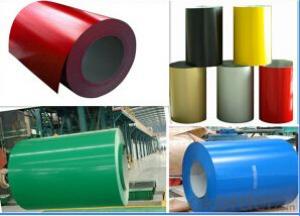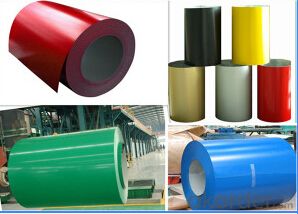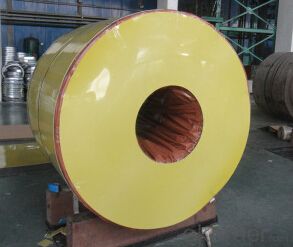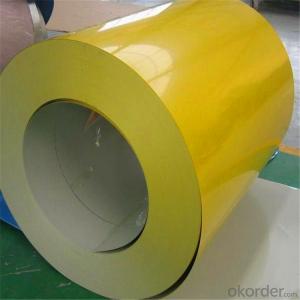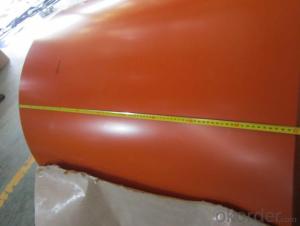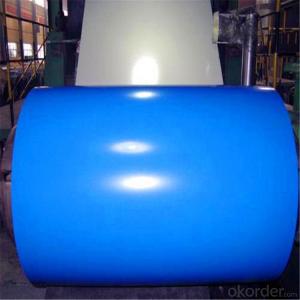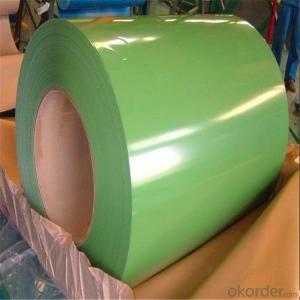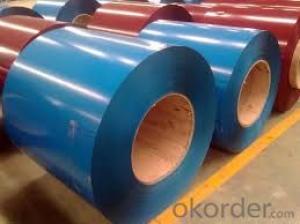PPGI Prepainted Galvanized Rolled Steel Coil
- Loading Port:
- Tianjin
- Payment Terms:
- TT OR LC
- Min Order Qty:
- 25 m.t.
- Supply Capability:
- 10000 m.t./month
OKorder Service Pledge
OKorder Financial Service
You Might Also Like
Description:
Model NO.:Thickness: 0.125--1.3mm*600-1250mm
Type:Steel Coil
Technique:Hot Rolled
Standard:ASTM, GB, JIS
Surface Treatment:Coated
Special Use:High-strength Steel Plate
Pre-Painted Steel Coi:Width: 610/724/820/914/1000/1200/1219/1220/1250mm
Export Markets:North America, South America, Southeast Asia, Africa, Mid East, Eastern Asia
Additional Info.
Trademark:SGCH
Packing:Standard Packing to Export.
Standard:0.2mm*914mm 0.3mm*1000mm
Origin: China
HS Code:721070100
Production Capacity:8000mt/Month
Product Description
Pre-painted Galvanized Steel Coil
PPGI is made by cold rolled steel sheet and galvanized steel sheets as baseplate,
through the surface pretreatment (degreasing, cleaning, chemical conversion
processing), coated by the method of continuous coatings (roller coating method),
and after roasting and cooling.
SPECIFICATION
1.Standard: AISI, ASTM, BS, DIN, GB, JIS
2.Grade: DX51D+Z, DC51D, SPCC, SGCC, SGHC, CGCC,
3.Surface Treatment Coated: Galvanized, Paint sealant, Coating passivation solution
Substrate Cold rolled, Galvanized sheet
4.Color: RAL Color card
5.Coil ID: 508/610 mm
6.Coil weight: 4-10MT
7.Paint film Front side: 10~25um
Back side: 5~10um
8.Zinc layer: 40~180g per square meter
9.Thickness: 0.125~1.3mm
10.Width: 600~1250mm
11.Length: As requirement
12.Type: Steel plate, Steel Coil, Roofing metal
13.Place of origin: Shandong CHINA(mainland)
14.Deliver time: 20-30 days after receipt of advanced t/t or L/C
Advantages
1. Our company produce various specification and models and national standards of galvanized steel coil
2. Using high-quality material and advanced production technology and equipment for processing
3.Applicable to a humid climate and the harsh corrosive environment
4. Products has been all over the country more than 20 provinces, municipalities and
autonomous regions, and have been exported to Europe, North American, the Middle East,
the South East Asia, Africa, Asia,European and other countries and regions, well received by our buyer.
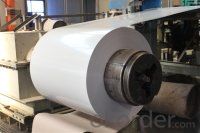
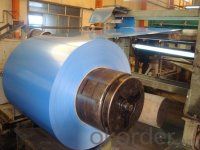
| commodity | prepained Galvanized Steel Coil (PPGI/ PPGL) |
| Techinical Standard: | JIS G3302-1998, EN10142/10137, ASTM A653 |
| grade | TSGCC, TDX51D / TDX52D / TS250, 280GD |
| Types: | For general / drawing use |
| Thickness | 0.125-1.3mm(0.16-0.8mm is the most advantage thickness)) |
| Width | Width: 610/724/820/914/1000/1200/1219/1220/1250mm |
| Type of coating: | PE, SMP, PVDF |
| Zinc coating | Z40-180g/m2 or AZ40-100g/m2 |
| Top painting: | 5 mic. Primer + 15 mc. R. M. P. |
| Back painting: | 5-10 mic. EP |
| Color: | According to RAL standard |
| ID coil | 508mm / 610mm |
| Coil weight: | 4--8MT |
| Package: | Properly packed for ocean freight exportation in 20' ' containers |
| Application: | Industrial panels, roofing and siding for painting / automobile |
| Price terms | FOB, CFR, CIF |
| Payment terms | 20%TT in advance+80% TT or irrevocable 80%L/C at sight |
| delivery time | 25 days after recepit of 20% TT |
| Remarks | Insurance is all risks |
| MTC 3.1 will be handed on with shipping documents | |
| We accept SGS certificatation test |
- Q: What are the challenges in coil recoiling for high-strength steel?
- Coil recoiling for high-strength steel presents several challenges that must be addressed. To begin with, high-strength steel possesses heightened hardness and strength, rendering it more difficult to coil than regular steel. The greater tensile strength of high-strength steel places additional strain on the recoiling machinery, potentially resulting in damage or machinery failure. Moreover, high-strength steel tends to exhibit reduced ductility, meaning it is less able to endure deformation without fracturing. Recoiling high-strength steel coils necessitates meticulous handling and control to prevent excessive bending or stretching that could lead to material breakage or cracking. Another obstacle arises from the shape memory effect of high-strength steel, whereby the material returns to its original shape after being deformed. Although this property can be advantageous in certain applications, it complicates the recoiling process as the steel coil resists reshaping into a new coil form. Furthermore, high-strength steel often possesses a more intricate microstructure compared to regular steel, characterized by various phases and grain boundaries. This complexity can heighten the difficulty of the recoiling process, as it can impact the material's mechanical properties and response to deformation. Finally, the surface finish of high-strength steel coils is crucial for many applications. Recoiling can introduce surface defects, such as scratches or marks, which may impair the functionality or appearance of the final product. Consequently, maintaining a high-quality surface finish during the recoiling process poses a significant challenge. In summary, the challenges associated with coil recoiling for high-strength steel encompass increased stress on recoiling equipment, reduced ductility, the shape memory effect, complex microstructure, and the need for a high-quality surface finish. Overcoming these challenges necessitates specialized equipment, precise control, and careful handling to ensure the integrity and quality of the recoiled high-strength steel coils.
- Q: What are the different types of steel coil grades and specifications?
- In the market, one can find a variety of steel coil grades and specifications. These grades and specifications cater to different industry needs and applications. Several commonly used types include: 1. Hot Rolled Steel Coils: These coils are manufactured by heating the steel above its recrystallization temperature and then rolling it at a high temperature. They are often used in applications where dimensional accuracy and surface finish are not crucial. 2. Cold Rolled Steel Coils: Cold rolled steel coils are produced by subjecting hot rolled coils to further processing in cold reduction mills. This process enhances surface finish, tightens tolerances, and increases strength compared to hot rolled coils. They find wide applications in the automotive, construction, and electrical industries. 3. Galvanized Steel Coils: These coils are coated with a layer of zinc to protect them from corrosion. Galvanization improves the durability and longevity of the steel coils. They are commonly used in roofing, fencing, and automotive body parts. 4. Stainless Steel Coils: Made from a combination of iron, chromium, and other elements, stainless steel coils offer excellent corrosion resistance and high strength. They are widely used in industries such as food processing, chemical, and medical, where hygiene and corrosion resistance are critical. 5. High-strength Low-alloy (HSLA) Steel Coils: HSLA steel coils are designed to possess higher strength and improved formability compared to conventional carbon steels. They are commonly employed in structural and transportation applications where weight reduction and high strength are required. 6. Electrical Steel Coils: Also known as silicon steel or transformer steel, these coils are specifically designed for electrical equipment like transformers, motors, and generators. They exhibit low core losses and high magnetic permeability, ensuring efficient energy transfer. 7. Tool Steel Coils: Tool steel coils are specially formulated to possess high hardness, wear resistance, and toughness. They are commonly used in the production of cutting tools, dies, and molds. These examples represent only a fraction of the steel coil grades and specifications available in the market. The choice of the appropriate grade and specification depends on specific application requirements, such as strength, corrosion resistance, formability, and surface finish.
- Q: How are steel coils used in the production of metal furniture?
- Steel coils are used in the production of metal furniture as the primary raw material for shaping and forming various components such as frames, legs, and supports. These coils are unrolled and cut into appropriate lengths, then undergo processes like bending, welding, and shaping to create the desired furniture pieces. The strength, durability, and malleability of steel make it an ideal material for constructing sturdy and long-lasting metal furniture.
- Q: pros and cons of stainless steel and carbon steel swords
- Well generally Stainless steel blades are machine made and are of a display quality.. so expect looks, but don't expect quality or functionality from one. From carbon steel, I'd say you'd be looking at swords for practitioners of a sword art, reenactment, and collector quality blades. Stainless Steel Pros: Good for short blades like kitchen knives, cheap, won't easily rust or corrode. Cons: Long blades like swords become increasingly brittle and can snap with light use, most lack actual tangs(part of the blade that keeps the blade in the handle.) and are just welded onto a wire that[if broken} will send the blade out like a missile when swung, these are cheap display quality only. Carbon Steel Pros: Are usually much stronger and of a higher quality than their stainless counterparts, are often handmade by professional sword-smiths, no two blades are alike, fully functional work of art. Cons: Requires responsible care and maintenance, will corrode and rust easier, can be much more expensive.
- Q: How are steel coils used in the production of steel tanks?
- Steel coils are used in the production of steel tanks by being cut and shaped into the desired size and shape of the tank. These coils are typically made of high-quality steel, which provides strength and durability to the tanks. The coils are processed through various manufacturing techniques like rolling, bending, and welding to create the tank's body, ensuring a seamless structure. Additionally, the coils can also be used to create the tank's base, lid, and other components, resulting in a complete and sturdy steel tank suitable for various applications.
- Q: What is the average width tolerance for steel coils?
- The average width tolerance for steel coils can vary depending on the specific industry and application, but typically it ranges from ±0.005 to ±0.25 inches.
- Q: Are steel coils corrosion-resistant?
- Yes, steel coils can be corrosion-resistant depending on the type of steel used and any additional protective coatings applied.
- Q: I want to make a chess set out of stainless steel, but I'm not sure what type of mold I need or where I can go to have the steel melted and molded for me. Any ideas? I live in Southern, NJ.
- I'll buy one. You'll have to machine it from blocks... You could invest in a milling machine - they are like drill presses and lathes all together and more... If you hook it up to your computer, you can do a CNC milling, where you can get really creative and finely detailed. Stainless is heavy and hard, so it'll go through your bits, and you should use the super duty bits as well. I have always wanted an SS chess set, I made a board out of leather. It's really super awesome, just need your pieces now. Or make mine from Plutonium, or Tungsten Carbide.
- Q: Are steel coils used in automotive manufacturing?
- Yes, steel coils are commonly used in automotive manufacturing. They are used to make various components of vehicles such as body panels, chassis, and suspension systems. The high strength and durability of steel make it an ideal material for ensuring the safety and performance of automobiles.
- Q: What are the common methods of transporting steel coils?
- Depending on factors such as coil size, weight, destination, and specific handling requirements, there are various common methods for transporting steel coils. These methods include: 1. Short-distance transportation: For short distances, steel coils are often transported using flatbed trucks. These trucks have a flat trailer bed that allows for easy loading and unloading of the coils. To prevent movement during transit, the coils are secured and strapped down. 2. Long-distance transportation: Rail transport is commonly preferred for longer distances due to its cost-effectiveness and efficiency. Specially designed railcars, known as coil cars or gondola cars, are used to securely hold the coils in place. This method is particularly advantageous for large quantities of steel coils. 3. International or long-distance transport: Shipping by sea is a common method for transporting steel coils internationally or over long distances. The coils are loaded into specialized shipping containers with internal cradles to prevent movement and damage during transit. These containers are then loaded onto cargo ships. 4. Waterway transportation: In regions with navigable waterways, barges can be used to transport steel coils. Similar to ocean freight, the coils are loaded into specially designed containers or barges with cradles to secure them during transport. Barge transport offers an economical and environmentally friendly option, especially for inland waterway transportation. 5. Combined transportation: In certain cases, a combination of different transportation modes, known as intermodal transport, may be used. For instance, steel coils can be initially transported by truck and then loaded onto railcars for long-distance transport. This approach allows for the optimization of cost and efficiency by utilizing the advantages of different transportation modes. It's important to note that the specific method of transporting steel coils can vary based on various factors, including coil size, weight, destination, and any specific handling requirements.
Send your message to us
PPGI Prepainted Galvanized Rolled Steel Coil
- Loading Port:
- Tianjin
- Payment Terms:
- TT OR LC
- Min Order Qty:
- 25 m.t.
- Supply Capability:
- 10000 m.t./month
OKorder Service Pledge
OKorder Financial Service
Similar products
Hot products
Hot Searches
Related keywords
